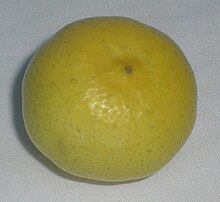Key lime
| Key Lime | |
|---|---|

| |
| Tree-ripened key lime. Color is bright yellow, unlike the more common green Persian limes. | |
| Scientific classification | |
| Kingdom: | |
| (unranked): | |
| (unranked): | |
| (unranked): | |
| Order: | |
| Family: | |
| Genus: | |
| Species: | C. aurantifolia
|
| Binomial name | |
| Citrus aurantifolia (Christm.) Swingle
| |
The Key lime (Citrus aurantifolia) is a citrus species with a globose fruit, 2.5–5 cm in diameter (1–2 in), that is yellow when ripe but usually picked green commercially. It is smaller, seedier, has a higher acidity, a stronger aroma, and a thinner rind than that of the Persian lime (Citrus x latifolia). It is valued for its unique flavor compared to other limes, with the key lime usually having a more tart and bitter flavor. The name comes from its association with the Florida Keys, where it is best known as the flavoring ingredient in Key lime pie. It is also known as West Indian lime, Bartender's lime, Omani lime, Tahitian lime or Mexican lime, the latter classified as a distinct race with a thicker skin and darker green color.
Description
C. aurantifolia is a shrubby tree, to 5 m (16 ft), with many thorns. Dwarf varieties are popular with home growers and can be grown indoors during winter months and in colder climates. The trunk rarely grows straight, with many branches that often originate quite far down on the trunk. The leaves are ovate 2.5–9 cm (1–3.5 in) long, resembling orange leaves (the scientific name aurantifolia refers to this resemblance to the leaves of the orange, C. aurantium). The flowers are 2.5 cm (1 in) in diameter, are yellowish white with a light purple tinge on the margins. Flowers and fruit appear throughout the year but are most abundant from May to September [1] [2].
History
C. aurantifolia is native to Southeast Asia. Its apparent path of introduction was through the Middle East to North Africa, thence to Sicily and Andalusia and via Spanish explorers to the West Indies, including the Florida Keys. From the Caribbean, lime cultivation spread to tropical and sub-tropical North America, including Mexico, Florida, and later California [3].
Since the North American Free Trade Agreement came into effect, many Key limes on the US market are grown in Mexico and Central America. They are also grown in Texas and California.
When in contact with the skin, the Key lime can sometimes cause Phytophotodermatitis, in which a chemical reaction makes the skin extra sensitive to ultraviolet light.
Propagation
This variety of citrus can be propagated from seed and will grow true to the parent. Digging around a mature tree to sever roots will encourage new sprouts that can be transplanted to another location. Cuttings can be used to propagate new trees but normally do not develop strong roots. Clones are often bud grafted[4][5] into rough lemon or sour orange to obtain strong root stocks. Lime trees like soil with good drainage [6][7]. Also see Fruit tree propagation.
Name

The English word "lime" was derived, via Spanish then French, from the Arabic word ليمة līma (Persian لیمو Limu).[8] "Key" would seem to have been added some time after the Persian lime cultivar gained prominence commercially in the United States following the 1926 Miami hurricane, which destroyed the bulk of US C. aurantifolia agriculture, leaving it to grow mostly casually in the Florida Keys.[9][10]
In Malay it is known as "limau nipis", literally, "thin lime".
Footnotes
- ^ Alphabetical List of Plant Families with Insecticidal and Fungicidal Properties
- ^ Citrus aurantifolia Swingle
- ^ Citrus aurantifolia Swingle
- ^ Citrus aurantifolia Swingle
